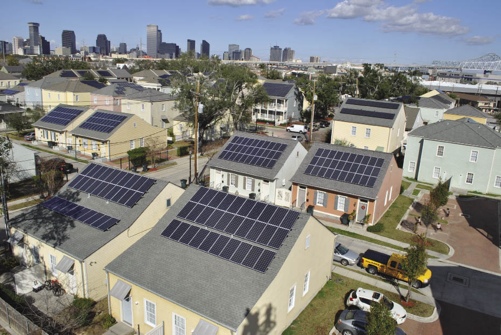Solar neighborhoods are gaining ground in lower income housing projects, here are some recent examples.
Since Hurricane Katrina, government agencies have joined to foster new sustainable housing developments powered by renewable energy.
One of those is in Louisiana, now home to the biggest solar neighborhood in the southeast. The new mixed-income River Garden Apartments replaces the St. Thomas Housing Project, which was known as a high-crime zone before it was destroyed by Hurricane Katrina.
The eight-block neighborhood has 420 kilowatts of solar rooftop PV. Developer HRI Properties is investing $10 million in 1.05 megawatts of solar on six other apartment complexes in the New Orleans area.

This is also Louisiana’s biggest solar project to date.
"This project will demonstrate the proven technology and long-term viability of solar energy in Louisiana," says Wade Byrd, president of Performance Building Consulting, a partner on the installations. "The project will employ multi-crystalline solar panels with 25-year output warranty and state-of-the-art inverters that will track and optimize the output from every single panel."
A built-in fire prevention safety system kicks in if the panels are damaged in a hurricane or other destructive storm.
Residents will pay $0.10 cents per kilowatt-hour for electricity, saving about $50 per month on utility bills compared with other local power sources.
Habitat for Humanity Expands Efforts
Habitat for Humanity is building a 12-unit low-income housing project powered by solar.
It’s being built in Oakland, California in partnership with PG&E’s Solar Habitat Program. PG&E funds the full cost of solar PV systems on every Habitat-built home in Northern and Central California.
Another example is in Denver, where the Housing Authority is adding more than 2.5 MW of solar to 387 affordable housing buildings.
In a progress report on green affordable housing, Green Global USA notes that its influence is growing steadily.
"Over the past decade, green building strategies have become increasingly integrated into the nearly 100,000 units constructed annually under the Low-Income Housing Tax Credit (LIHTC) program, and significant strides have been made toward producing higher quality, more efficient dwellings that mitigate negative environmental impacts.
These benefits include a 20% or more reduction in utility costs; dramatically reduced or eliminated exposure to formaldehyde, volatile organic compounds (VOCs), other environmental toxins, and asthma triggers; reductions in transportation costs; 50% or more reduction in construction waste; 20% reduction in water use; and reductions in greenhouse gas emissions. Green affordable housing projects also help revitalize communities by considering proximity to transportation, infrastructure, jobs, and services."
Green Global USA analyses the performance of these programs, with a focus on four main areas:
- smart growth (such as brownfield redevelopment measures or habitat preservation);
- energy efficiency (including the use of solar PV and Energy Star specifications);
- resource conservation (including water consumption and use of renewable materials);
- health protection (such as abatement of lead-based paint and asbestos-containing materials).
Based on these factors, two states received perfect scores for their policies supporting affordable housing: Connecticut and Maryland.
Another two received solid "A" scores: New Jersey and Washington, and the state showing the biggest improvement was Ohio.
Here’s Global Green’s progress report:
